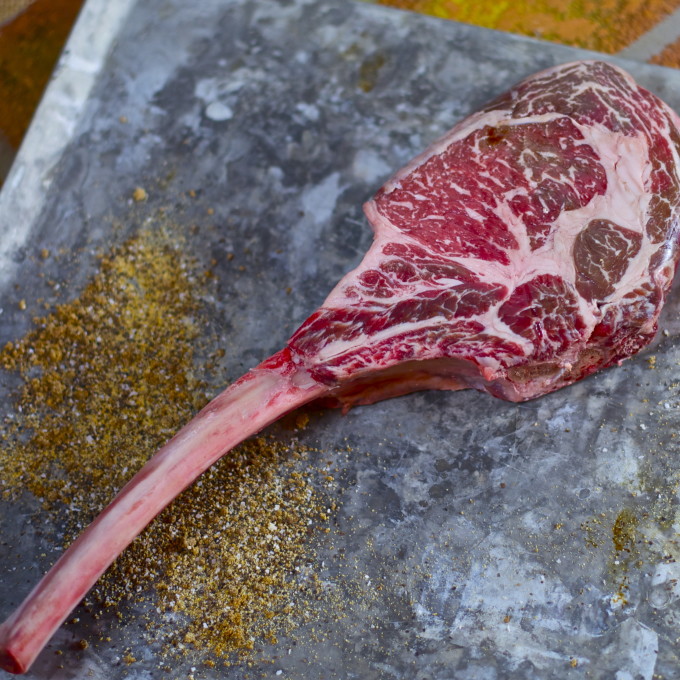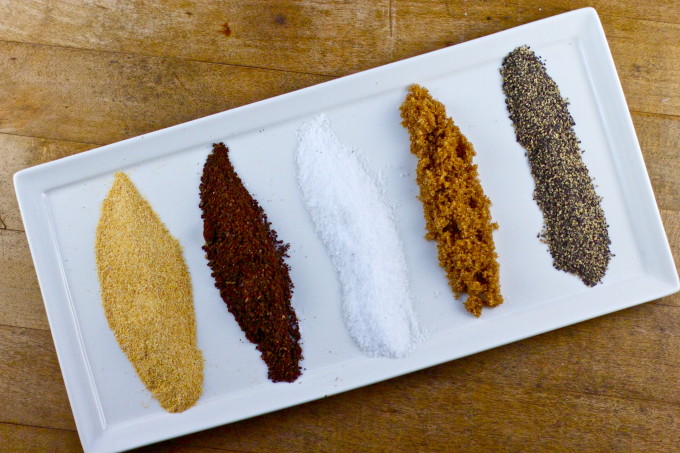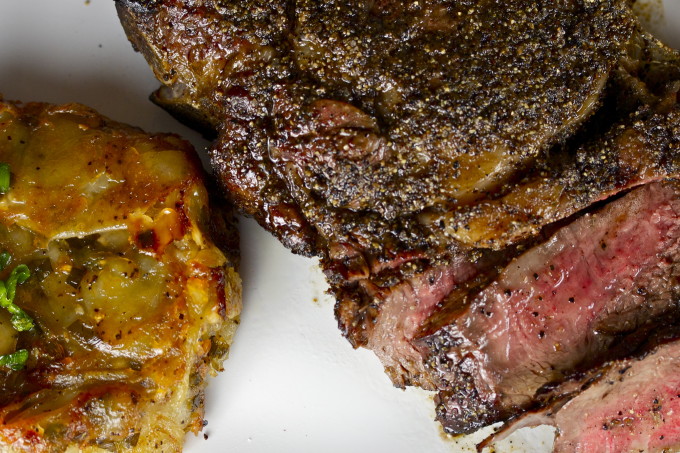Now and then, I must seek out the thickest cut of beef I can find for a manly meal. It is a primal urge. Cooking steaks portioned in gargantuan slabs are not really about the quantity of the meat, but rather it is all about the quality of the outcome. Let me explain.

Tomahawk Ribeye: Cooked on the bone, this is steak perfection. (All photos credit: George Graham)
Over the years of trial and error cooking beef steak, I have found that there are secrets to achieving perfection. First, is selecting the right cut of beef with a significant enough fat content, or marbling, that ensures a juicy and tender outcome. Next, is forming an outer crust that creates texture and taste, but also seals in those flavorful juices. Then, in achieving steak nirvana, it is important to cook a steak to perfect medium rare and to cook by temperature, not by sight. In my book, 125ºF is perfectly rare and time to remove a steak from the heat. The residual carryover will continue to cook the meat internally to juicy pink medium rare. And finally, the thicker the steak, the more precise you will be in achieving a crusty outer shell without overcooking the center.

A perfectly marbled bone-in tomahawk ribeye cut.
My wife swears by filet mignon. Many others I know—gourmands among them—insist that the New York strip sirloin is the “king of steaks,” and I have had some spectacular versions of that cut. But, for my money, ribeye tops them all. More specifically, I search for the bone-in cut, usually referred to as the cowboy ribeye. But, every now and again I stumble upon the cut of all cuts—the tomahawk ribeye. With a perfect two-inch-thick cut of marbled beef connected to the long, extended rib bone, this tomahawk ribeye is a dramatic presentation and one that will elicit oohs and aahs of gastronomic delight.

Jay Owen, the steak master, serving up a grilled sausage appetizer at the lodge.
But, how do you cook a slab of beef this size? My friend Jay Owen knows. I call him the “steak master,” and I can assure you from firsthand knowledge, this guy knows his way around a grill. I’ve cooked with him on numerous occasions, and I am consistently impressed with his knowledge and expertise. Jay’s specialty is 28-day, dry-aged porterhouse steak, and the method he uses—reverse searing—results in beef perfection.
Following Jay’s lead, I am using the reverse sear method for cooking my Tomahawk Ribeye to perfect doneness before searing to form a crust. With standard-size steaks, I would simply apply a rub and toss on the hottest part of the grill, and by the time the exterior crust forms, the inside is a pink and rosy medium rare. But, with larger cuts like my tomahawk ribeye cut, as well as prime rib roasts, it is essential to reverse the method by cooking low and slow until the internal temperature reaches 125ºF, and then you can finish it off over high heat.

Community Coffee—a dark Louisiana brew—is the key to this steak spice rub for my Tomahawk Ribeye.
To achieve maximum flavor and that crusty exterior for my Tomahawk Ribeye, I use a rub that I have developed for grilling beef of all types—steaks, short ribs, and burgers, too. Finely ground Community coffee beans, when blended with garlic powder, kosher salt, coarsely ground black pepper, and dark brown sugar creates a coating that balances out as a dark and rich, salty, yet sweet, peppery punch. The ingredients are a simple infusion of umami-inducing earthiness to achieve that primal and basic beef flavor.

Shave the potatoes thinly with a vegetable peeler.
When I eat a steak like my Tomahawk Ribeye, I do not want to be distracted with salads and vegetables, but rather a simple side of my simplistic shaved potatoes bathed in a dab of horseradish, a splash of crema and a sprinkling of grated Swiss. Oh, and of course, a glass of bold Cabernet to compliment the heft of this manly meal.
Let’s cook steak.
- ½ cup dark roast whole bean coffee, finely ground, such as Community Coffee
- ½ cup dark brown sugar
- ½ cup kosher salt
- ½ cup garlic powder
- ½ cup coarsely ground black pepper
- 2 large russet potatoes
- 1 tablespoon horseradish
- 2 tablespoons grated yellow onion
- ½ cup grated Swiss cheese
- 1 tablespoon heavy cream
- Kosher salt and freshly ground black pepper
- 2 (2-pound) tomahawk-cut bone-in ribeye steaks
- Kosher salt
- 2 tablespoons canola oil
- In a mixing bowl, add coffee, brown sugar, salt, garlic powder, and pepper, and mix well to combine evenly. Cover and move to the side.
- Preheat the oven to 375ºF.
- Peel the potatoes and discard the peels. Using the peeler, thinly slice the potato in short 1-inch lengths.
- In a mixing bowl, combine the potato slices with horseradish, grated onion, cheese, and cream. Stir to combine and season with salt and pepper.
- In individual ramekins coated with non-stick spray, pack the potato mixture and press down to compact the mixture. Invert the dishes to let any moisture escape.
- Place the ramekins bottom side down on a baking sheet and bake for 30 minutes until the potatoes are browned and cooked through, about 30 minutes.
- Preheat the oven to 300ºF.
- Remove the steaks from the refrigerator and salt them liberally with kosher salt. Place on a tray lined with paper towel and let them rest for 1 hour until they come to room temperature. Remove the paper towels (they should be wet from residual moisture pulled from the steaks during salting), and wipe off any remaining salt from both sides of the steak. Place the steaks on a baking tray and position on the center rack of the oven.
- Roast uncovered until the internal temperature (use a wire probe thermometer if you have one) reaches 125ºF, 30 to 40 minutes. Remove from the oven.
- Brush only 1 side of each steak with the oil and liberally coat with the dry rub.
- On a gas grill set to high heat (use the infrared heating element if you have one), place the steaks on the hottest part of the grill. Without turning, watch to see that the rub is set and has formed a crust, 5 to 8 minutes. Remove from the grill and let rest for 10 minutes before serving.
- For serving, move the steaks to a cutting board and cut the meat away from the bone and into thick slices. Serve with the shaved potatoes.

Tomahawk Ribeye steak cooked perfect medium rare.
YOUR SEAT AT THE TABLE: If you like this Cajun cooking story and Cajun recipe then accept my personal invitation to subscribe by entering your email at the bottom or top right of this page. It’s quick and painless. You will receive an email alert and be the first to see when new Cajun cooking stories and Cajun recipes are added. Thanks, George.
Nice
That just has to be insanely good and that Shaved Potato Pie will be showing up on our table anytime of the day or night. Outstanding job !!!
Hey Howard – It is a great combination and let us know how yours turns out. Thanks for the comment.
I’ve only cooked Tomahawk steaks once. But after reading your recipe I will be doing them again soon.
Lucky you! Tomahawk ribeyes are a real treat, and whenever I see them I can’t resist. Let us know how it turns out.
George, does the crust side go face down or up on the grill. Thanks. I cannot wait
Hey Ian – Thanks for a great clarification question. Yes, the steaks go on the grill with the crust-side down. Here the deal: You are simply setting the dry rub and caramelizing the sugars on the exterior of the steak. Since the steak is already done in the interior, it should only take a few minutes over the hot grill. All the best.
Your steps are spot on..thanks for spelling it out with simplicity….looking forward to trying your rub…
I plan on making for father’s day
I want to cook my cowboy/tomahawk steak just exactly like i would cook/bake a standing prime rib roast. No searing at all. Can you tell me how long I should bake it and at what temperature for medium rare as I will eat it as soon as it comes out of the oven. No need to ‘rest” it I will eat it hot from the oven.
Thanks
Bill W
Hey Bill- As for cooking “time”, it is more about internal temperature than time, and I urge you to use a meat thermometer. For more specifics, I have detailed recipe instructions in my story and recipe. A word of caution: For best flavor and texture, you should sear the meat to develop an exterior crust, and you should allow the meat to rest for at least 10 minutes. Resting meat after cooking redistributes the juices and prevents all the flavor from running out onto your plate when you cut into it. Best of luck.
I’m in the same park as Bill Walters, I want to cook a tomahawk ribeye, so that when it’s finished, it will have
the texture of a prime rib roast. I have tried the oven method and I have tried sous vide.
My temperature range is spot on to what your recipe states.
Our local Sam’s Club always has the tomahawk–good price and they are Angus.
It’s also the perfect size steak for my wife and I.
First time in the oven, then reverse sear, was ok, just had that really rare area in the very center.
Cooked the second one via sous vide, came out where the inside was evenly cooked all the way thru.
Also did the reverse sear and it had a great crust.
But the texture was just like a grilled rib eye, not the prime rib roast texture.
Any ideas?
Dave- As you know, a Prime Rib cut is a larger cut of meat and is at its best when roasted to an even internal temperature. On the other hand, a ribeye steak is at its best when seared to seal in juices and to develop a crust. My cooking method is to treat the two cuts differently and enjoy each for their taste and texture. I hope this helps. All the best.
My first cow boy steak! Husband and both my teenager boys loved it! I made the potato pies too, I may put more cream in them next year. Thank you George!
I used your rub but seared the steak in a cast iron pan and then finished it in the oven. One of the best steaks I have ever had! Thank you for sharing!
Amanda- Thanks for the comment and all the best to you.
The hubby and I tried this tonight and it turned out very good and delicious. Thanks for the recipe
I am making this as I type this message. Can’t wait to dig in..
It’s just perfect. I followed the recipe, and it was excellent.
Thanks Tea.
Why do you not sear on both sides to achieve a crust?
Keri – With the reverse-sear method, you have already cooked the steak through to rare in the oven before finishing on the grill. Searing one-side only gives you the crust you are looking for and finishes cooking to medium rare without overcooking. To sear both sides of the steak risks the outcome being medium well. All the best.
Thanks for your prompt response as we are cooking these tonight with a side of saffron risotto. Can’t wait to try this cut of meat. I’ll definitely be trying your potatoes this week.
Does the crust have a prominent coffee taste?
I like coffee but my partner doesn’t .
Lisa- No, you won’t know it’s there, but there will be a depth of flavor that works deliciously with beef. Give it a try.
Trying this today. Sounds amazing!!
Hey there! We do not have a grill, is it still possible to use this method on stove top in cast iron skillet?
Danielle – Yes, but you will need an extra-large skillet to fit a Tomahawk Ribeye. Good luck!
George,
This may seem like a silly question, but since you sear only one side, do you sear the ribeye with rubbed side down or up?
Hey Tom – There are no silly questions, and yours is a good one. Place it on the grill rubbed-side-down. What you are doing is creating a crust with the spices, and the oil helps the spices stay in place and keeps the meat from sticking to the grill. All the best.